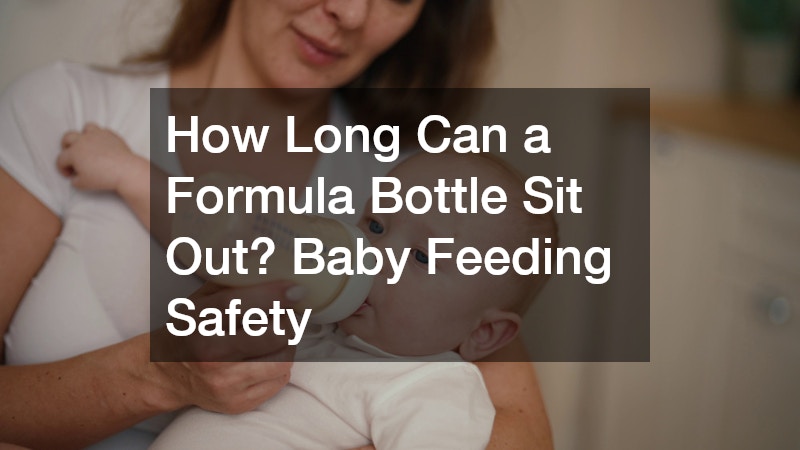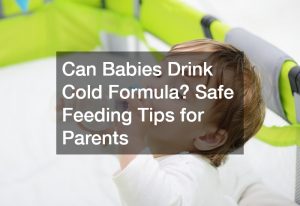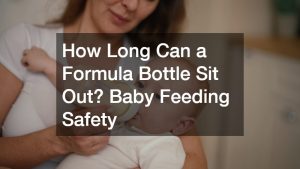Feeding your baby safely is a top priority for any parent. One common question is: how long can a formula bottle sit out before it becomes unsafe? Formula bottles, whether ready-to-feed or mixed from powder, can harbor bacteria if left at room temperature too long. Understanding safe handling, storage, and feeding practices is essential to protect your baby from illness.
This article provides comprehensive guidance on formula safety, tips for preparing and storing bottles, and signs that a bottle may have gone bad.
Types of Infant Formula
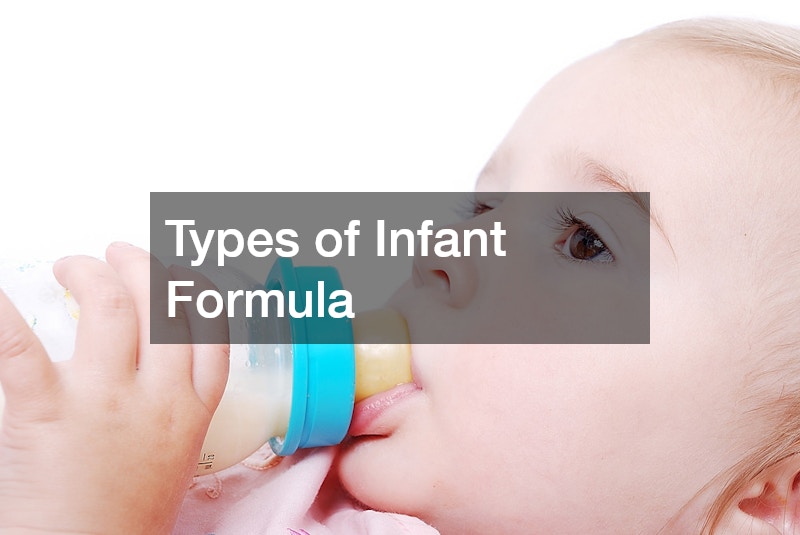
Infant formula comes in several forms, and each type has slightly different storage considerations:
- Powdered Formula: Must be mixed with water before feeding. It’s convenient and cost-effective but can develop bacteria once mixed.
- Liquid Concentrate: Requires dilution with water. Once mixed, it should be treated like prepared formula.
- Ready-to-Feed: Comes pre-mixed and sterile. Once opened, it should be treated carefully and stored properly.
Each type requires attention to hygiene and timing to ensure your baby’s safety.
Safe Time Limits for Formula
The amount of time a formula bottle can sit out depends on whether it has been used or prepared:
- Prepared Formula (Room Temperature): Can sit out safely for up to 2 hours. After that, bacteria can multiply, increasing the risk of illness.
- Formula in the Fridge: Prepared bottles can be stored for up to 24 hours in the refrigerator at 40°F (4°C) or below.
- After Baby Starts Feeding: Any formula left in the bottle should be discarded within 1 hour, as saliva introduces bacteria that multiply quickly.
- Frozen Formula: Can be stored in the freezer for 1–2 months depending on brand instructions, then thawed in the fridge before use.
Tip: Always label bottles with the time they were prepared to avoid accidentally using formula that has been sitting out too long.
Why Timing Matters
Bacteria growth is the main reason formula bottles have strict time limits. Formula can support the growth of harmful bacteria like Salmonella and E. coli if left at room temperature too long. Babies have underdeveloped immune systems, making them more susceptible to infections. Over time, some nutrients in the formula may also degrade, especially if exposed to heat or sunlight.
To reduce risk and keep your baby safe:
- Always prepare formula with clean hands and sanitized bottles.
- Never leave formula in a warm car or near heat sources.
- Follow the manufacturer’s guidelines for preparation and storage.
- Discard any formula left at room temperature for more than 2 hours.
- Label bottles with the preparation time to avoid accidental use of old formula.
These precautions help ensure your baby’s formula stays safe, nutritious, and ready for feeding.
Tips for Preparing Formula Safely
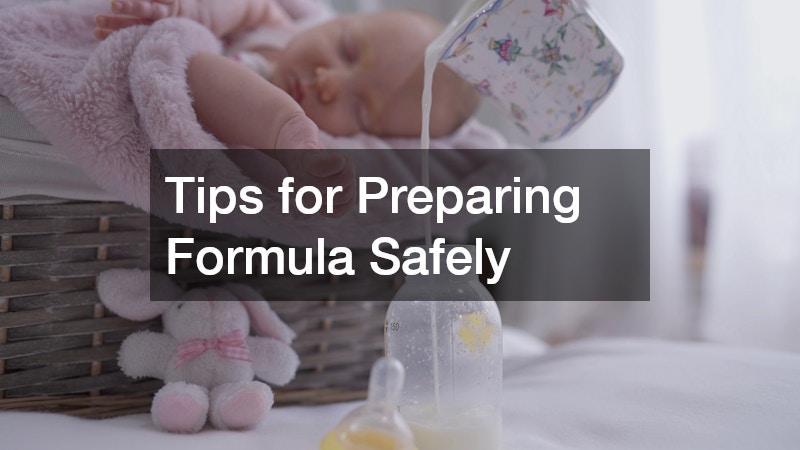
Proper preparation is essential to keep formula safe, maintain its nutritional value, and reduce waste. Following these guidelines can help protect your baby from harmful bacteria and ensure every feeding is safe and healthy.
- Wash Hands Thoroughly: Before preparing bottles, wash your hands with soap and warm water for at least 20 seconds. This reduces the risk of transferring bacteria to the formula or feeding equipment. Make sure to dry your hands with a clean towel or air dryer.
- Sterilize Bottles and Nipples: Especially important for newborns, preterm infants, or babies with weakened immune systems. Sterilize bottles, nipples, and caps by boiling them for 5 minutes or using a steam sterilizer. Rinse thoroughly with clean water before use.
- Use Clean Water: Always follow the formula manufacturer’s instructions for the type and temperature of water. Tap water should be safe if it meets local safety standards, but some parents prefer using filtered or boiled water to reduce potential contaminants. Using the correct water temperature also ensures the formula mixes properly and preserves nutrients.
- Mix Just Before Feeding: Only prepare the amount of formula your baby will consume within a short period, typically 2 hours at room temperature. Avoid pre-mixing large quantities in advance, as bacteria can multiply quickly in formula left out too long. If you need extra bottles, store them in the refrigerator immediately.
- Avoid Microwaving: Microwaving bottles can heat formula unevenly, creating hot spots that may burn your baby’s mouth or throat. Instead, warm bottles safely in a bowl of warm water or use a bottle warmer. Always test the temperature by shaking the bottle and placing a few drops on the inside of your wrist before feeding.
- Label Bottles: To avoid confusion, label each bottle with the time it was prepared. This simple step ensures you don’t accidentally give your baby formula that has been sitting out too long.
- Check for Signs of Spoilage: Even if prepared correctly, inspect formula before feeding. Look for unusual odors, clumps, or color changes. Discard any bottle that shows signs of spoilage to keep your baby safe.
By following these steps, parents can ensure every bottle is prepared safely, reducing the risk of illness and maintaining the nutritional quality of the formula.
Transporting Formula Safely
Parents on the go need practical ways to keep formula safe:
- Insulated Bags: Use cooler bags with ice packs for bottles that will be used within 2–4 hours.
- Single-Serve Bottles: Consider pre-measured powdered formula packets to mix with water as needed.
- Check Temperatures: Bottles should feel lukewarm to the touch and never left in a hot car.
Tip: If a bottle has been sitting in a warm environment for more than 2 hours, discard it to prevent risk.
Signs Formula May Have Gone Bad
Checking formula before feeding is crucial to ensure your baby’s safety. Even formula that has been stored properly can spoil if left out too long or contaminated during preparation. Parents should look for the following warning signs:
- Unusual Smell: Formula that smells sour, rancid, or off in any way is a clear indicator of spoilage. Trust your senses—if it smells different than usual, discard it.
- Clumps or Separation: Some separation is normal in powdered formula, but excessive clumping or lumps that do not mix easily may indicate contamination or that the formula has gone bad. Shake well before feeding, and if the clumps remain, throw it out.
- Change in Color: Formula should maintain a consistent, creamy color. Darkening, discoloration, or a grayish tint can signal bacterial growth or spoilage.
- Texture or Consistency Changes: Formula that feels unusually thick, watery, or grainy may be spoiled or improperly prepared.
- Taste: Never taste formula yourself to check freshness, as it can contain bacteria harmful to adults. Always rely on the other signs above.
- Signs After Feeding Has Begun: Once your baby starts feeding, bacteria from saliva can enter the bottle. Any remaining formula should be discarded within 1 hour to prevent bacterial growth.
Parents should always err on the side of caution. If a bottle shows any of these signs, discard it immediately to ensure your baby’s health and safety.
Tips for Reducing Formula Waste
Handling formula properly helps prevent waste while keeping your baby safe:
- Prepare Small Amounts: Only mix what your baby is likely to consume within 2 hours.
- Store Extras in the Fridge: Refrigerate any unused portions promptly for up to 24 hours.
- Freeze if Necessary: If you have extra formula, freeze it according to manufacturer instructions.
- Label Bottles: Always include the preparation time on bottles to avoid confusion.
Special Considerations for Newborns and Preterm Babies
Newborns and preterm infants are more vulnerable to bacterial infections:
- Shorter Room-Temperature Window: Consider limiting time at room temperature to 1 hour for these babies.
- Strict Hygiene: Sterilize bottles after every use and handle with clean hands.
- Follow Pediatric Advice: Consult your pediatrician if you’re unsure about formula handling, especially for premature or immunocompromised infants.
FAQs About Formula Storage
Can I leave a formula bottle out overnight?
No. Formula left at room temperature for more than 2 hours should be discarded to avoid harmful bacterial growth.
Can I refrigerate partially used bottles?
It’s not recommended. Once your baby has started feeding, the bottle should be used within 1 hour.
Is ready-to-feed formula safer to leave out?
Ready-to-feed formula is sterile until opened, but once opened, the same 2-hour room temperature limit applies.
How can I keep formula safe while traveling?
Use insulated bags with ice packs, pre-measured powder, and prepare bottles just before feeding when possible.
Can formula be reheated?
Yes, but do not microwave directly. Warm in a water bath and discard any leftover after feeding.
Conclusion
Understanding how long a formula bottle can sit out is crucial for keeping your baby safe and healthy. Formula left at room temperature for too long can quickly become a breeding ground for bacteria, which may lead to illness. Proper preparation, careful storage, and timely feeding are essential to protect your infant.
Always prepare formula with clean hands, use sterilized bottles, and refrigerate any unused portions promptly. Be mindful of the two-hour room temperature limit and discard any formula left in the bottle after feeding has begun. By following these safety guidelines, parents can ensure their baby receives nutritious formula while minimizing the risk of contamination and creating a safer feeding routine.

